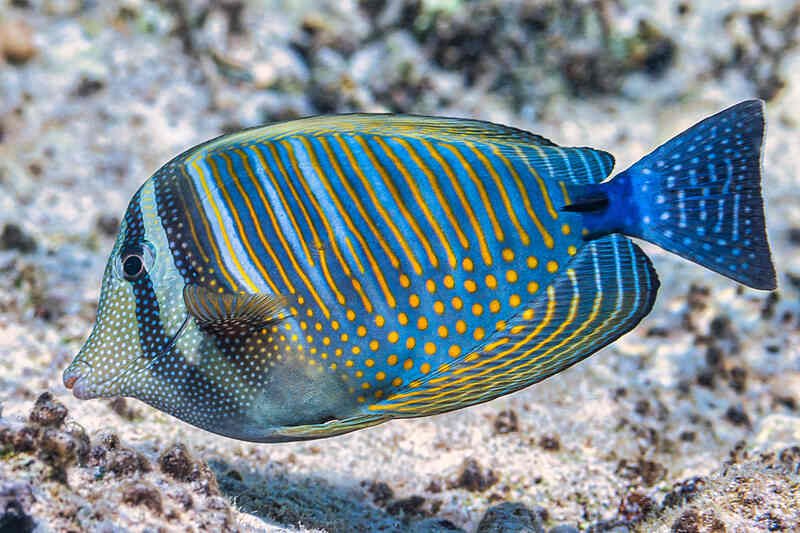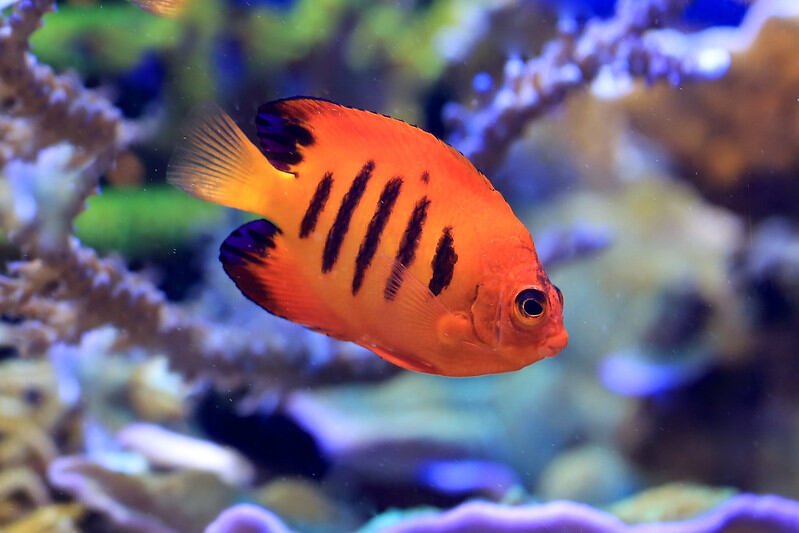Sailfin Tang fish, known for their stunning appearance and unique fins, are a popular choice among marine aquarium enthusiasts. Their vibrant colors and distinctive patterns make them a standout addition to any tank.
However, keeping Sailfin Tang fish requires a good understanding of their specific needs and behaviors. This guide will provide you with all the essential information on how to keep Sailfin Tang fish happy and healthy in your aquarium.
Introduction to Sailfin Tang Fish
Sailfin Tang fish, scientifically known as Zebrasoma velifer, are native to the Indo-Pacific region. They are easily recognizable by their tall, sail-like dorsal fin and bold stripes.
These fish can grow up to 15 inches in the wild but typically reach around 10 inches in captivity. They are generally peaceful but can become territorial, especially in Smaller Tanks.
Tank Requirements
Tank Size: Sailfin Tang fish require a spacious tank to thrive. A minimum of 100 gallons is recommended, but larger tanks are preferable. The ample space allows them to swim freely and reduces stress.
Water Parameters: Maintaining stable water conditions is crucial. The ideal temperature range is 72-78°F (22-26°C), with a pH level of 8.1-8.4. Salinity should be kept between 1.020-1.025 specific gravity. Regular water testing and maintenance are essential to ensure these parameters are met consistently.
Aquascaping: Sailfin Tangs enjoy a well-structured environment with plenty of hiding spots and swimming space. Live rock formations provide natural grazing areas and shelter. Ensure there are ample open areas for them to swim and explore.
Note: Read Mor: Aquarium books and How to Remove Broum Algae Aquarium.
Diet and Feeding
- Herbivorous Diet: Sailfin Tang fish are primarily herbivores. In the wild, they graze on algae and seaweed. In captivity, their diet should consist mainly of marine-based algae, seaweed, and high-quality herbivore pellets or flakes. Offering a variety of foods helps ensure they receive all necessary nutrients.
- Supplementary Foods: While their diet is predominantly plant-based, occasional treats of myseed shrimp or brine shrimp can be offered. These supplements provide additional protein and variety but should not be the mainstay of their diet.
- Feeding Schedule: Sailfin Tangs are grazers and benefit from frequent, small feedings throughout the day. Aim for 2-3 feedings daily, ensuring they have access to algae sheets or other plant-based foods.
Social Behavior and Tank Mates
- Compatibility: Sailfin Tangs are generally peaceful but can exhibit territorial behavior, particularly towards other tangs. It is advisable to keep only one Sailfin Tang per tank unless the aquarium is very large and can accommodate multiple territories.
- Suitable Tank Mates: They can coexist with a variety of other marine species, including clownfish, gobies, wrasses, and other non-aggressive fish. Avoid housing them with overly aggressive species that might stress or harm them.
- Territorial Behavior: If keeping multiple tangs, introduce them simultaneously to reduce territorial disputes. Providing ample hiding spots and visual barriers within the tank can help mitigate aggression.
Health and Disease Prevention
- Common Diseases: Sailfin Tang fish are susceptible to common marine diseases such as Marine Ich (Cryptocaryon irritans) and Marine Velvet (Amyloodinium ocellatum). Regular observation and prompt action are key to disease prevention and management.
- Quarantine New Additions: Before adding additional fish to your primary tank, make sure they are quarantined first. This practice helps prevent the spread of diseases and allows you to monitor new arrivals for any signs of illness.
- Water Quality: Maintaining high water quality is vital for the health of Sailfin Tangs. Regular water changes, efficient filtration, and consistent monitoring of water parameters are essential practices.
Breeding Sailfin Tang Fish
Breeding in Captivity: Breeding Sailfin Tang fish in captivity is challenging and rarely occurs. They have specific requirements and behaviors that are difficult to replicate in an aquarium setting.
Spawning Conditions: In the wild, Sailfin Tangs spawn in pairs. Replicating these conditions in captivity requires a large, well-established tank with pristine water quality. Even with optimal conditions, successful breeding is not guaranteed.
Raising Fry: If breeding is successful, raising the fry requires a separate tank with specialized care. The larvae are very delicate and need specific conditions to survive and thrive.
Tips for Keeping Sailfin Tang Fish
- Algae Control: Since Sailfin Tangs are herbivores, they help control algae growth in your tank. Encourage natural algae growth on live rocks as a supplementary food source.
- Stress Reduction: Minimizing stress is crucial for the health of Sailfin Tangs. Avoid sudden changes in water conditions, overstocking, and aggressive tank mates.
- Regular Monitoring: Keep a close eye on your Sailfin Tang’s behavior, appetite, and overall health. Early identification of any problems enables timely intervention and care.
- Provide Enrichment: Enrich your tank environment with varied aquascaping and feeding routines. This keeps your Sailfin Tang mentally stimulated and promotes natural behaviors.
- Professional Advice: Don’t hesitate to seek advice from experienced aquarists or marine fish specialists. They can provide valuable insights and guidance tailored to your specific setup and fish.
Basic Advice for Keeping Tang Fish
Keeping Sailfin Tang fish can be a rewarding experience for marine aquarium enthusiasts. Their vibrant colors and unique appearance add beauty and interest to any tank.
By understanding their specific needs and providing a suitable environment, you can ensure your Sailfin Tang thrives and remains healthy.
Remember to maintain stable water conditions, offer a varied diet, and monitor their behavior closely. With proper care and attention, your Sailfin Tang will be a magnificent and cherished addition to your marine aquarium.
Problems and Solutions in Keeping Sailfin Tang Fish with Aquarium Plants
Sailfin Tang fish (Zebrasoma velifer) are a captivating addition to marine aquariums, known for their striking appearance and relatively peaceful demeanor.
However, when keeping these fish in tanks with live aquarium plants, several challenges can arise. This article explores common problems and their solutions to help you successfully keep Sailfin Tang fish in a planted aquarium.
Introduction to Sailfin Tang Fish and Aquarium Plants
Sailfin Tang fish are native to the Indo-Pacific region and are admired for their tall, sail-like dorsal fins and bold stripes.
These fish require a well-maintained tank with specific water parameters to thrive. On the other hand, live aquarium plants contribute to the aesthetic appeal and ecological balance of the tank, providing benefits such as oxygenation, waste absorption, and natural habitat enrichment veliferum sailfin tang.
While combining Sailfin Tang fish with live plants can create a stunning and dynamic aquarium, it also presents unique challenges. Let’s delve into some common problems and their solutions.
Problem 1: Dietary Conflicts
Issue: Sailfin Tang fish are primarily herbivores, grazing on algae and plant material. This dietary preference can lead to conflicts when live plants are introduced into their environment. Sailfin Tangs may nibble on or uproot plants, leading to damaged or dying vegetation.
Solution:
Selective Planting: Choose hardy, fast-growing plants that can withstand occasional grazing. Examples include Java Fern, Anubias, and certain species of macroalgae.
Supplemental Feeding: Ensure your Sailfin Tang receives ample plant-based food, such as algae sheets and herbivore pellets, to reduce their inclination to feed on live plants. Feeding them multiple times a day can also help curb their appetite for tank plants.
Separate Grazing Areas: Create designated grazing zones with algae-covered rocks or seaweed clips to distract the Sailfin Tang from the live plants.
Problem 2: Water Quality Maintenance
Issue: Maintaining pristine water quality is crucial for both Sailfin Tang fish and live plants. However, the bioload from fish waste can increase nitrate levels, negatively affecting plant health and contributing to algae blooms.
Solution:
Regular Water Changes: Perform frequent water changes (at least 20% weekly) to maintain low nitrate levels. This helps create a balanced environment for both fish and plants.
Efficient Filtration: Use a high-quality filtration system with biological, mechanical, and chemical filtration stages. A protein skimmer can also help remove organic waste and improve water quality.
Plant Maintenance: Regularly trim and prune plants to remove decaying matter, which can contribute to nutrient imbalances. Healthy plant growth can also outcompete algae for nutrients.
Problem 3: Light Requirements
Issue: Sailfin Tang fish and live plants have different lighting needs. While plants require sufficient light for photosynthesis, excessive light can encourage algae growth, which can be detrimental to both the fish and the plants.
Solution:
Balanced Lighting: Choose a lighting system that provides adequate light for plant growth without promoting excessive algae. LED lights with adjustable intensity and spectrum are a good choice for controlling light conditions.
Light Duration: Limit the photoperiod to 8-10 hours per day to reduce algae growth. Use a timer to ensure consistent light cycles, which benefit both plants and fish.
Algae Management: Introduce algae-eating species, such as snails or herbivorous fish, to help control algae growth. Additionally, manually remove algae from the tank as needed, veliferum sailfin tang.
Problem 4: Territorial Behavior
Issue: Sailfin Tang fish can exhibit territorial behavior, particularly in smaller tanks or when introduced to new environments. This behavior can stress other tank inhabitants, including plants, leading to an
Final Thoughts
Keeping Sailfin Tang fish in a planted aquarium presents unique challenges, but can be highly rewarding with the right approach.
By understanding and addressing the dietary needs, water quality, lighting requirements, territorial behavior, and plant compatibility, you can create a thriving and harmonious environment for both the fish and the plants.
This guide provides a comprehensive overview of the common problems and solutions associated with keeping Sailfin Tang fish with live plants.
By following these guidelines and maintaining a balanced ecosystem, you can enjoy the beauty and benefits of a planted aquarium while ensuring the health and well-being of your Sailfin Tang fish.






